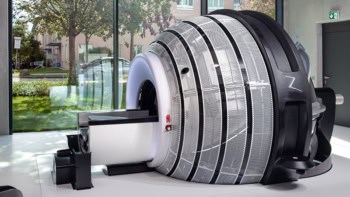
Low-intensity pulsed ultrasound with simultaneous administration of intravenous microbubbles (LIPU-MB) may effectively enable delivery of drugs across the blood–brain barrier (BBB) into the human brain. That’s the conclusion of a study from Northwestern University Feinberg School of Medicine in Chicago. The researchers report that the chemotherapy drug albumin-bound paclitaxel was safely delivered into the brains of 17 patients with recurrent glioblastoma, in a phase 1 dose-escalation clinical trial.
The study, reported in Lancet Oncology, provides the first direct evidence that LIPU-MB substantially increases the brain concentration of a systemically administered drug in humans. The researchers conclude that large-volume BBB opening is safe, reproducible, and can be repeated over multiple cycles of chemotherapy.
The BBB limits the penetration of many chemotherapy drugs, making treatment of malignant brain tumours challenging. The drug paclitaxel, for example, is approximately 1400 times more potent than the standard chemotherapy agents used for gliomas — but it cannot cross the BBB. In high-grade gliomas, however, tumour cells infiltrate into the parenchyma where they are protected from exposure to drugs. As a result, 80–90% of glioblastomas recur within the 2 cm margin of peri-tumoural brain around the tumour resection cavity.
Principal investigator Adam Sonabend, of the Northwestern Medicine Malnati Brain Tumor Institute, and colleagues conducted their study to evaluate the safety and maximal tolerated dose of albumin-bound paclitaxel after LIPU-MB-based opening of the BBB. They also aimed to assess the effect of LIPU-MB-based BBB opening on paclitaxel concentrations in peri-tumoural brain tissue.
The study included 17 patients whose recurrent glioblastoma was unresponsive to one or more previous treatments. Several of these patients were also participants in a separate clinical trial investigating LIPU-MB with carboplatin chemotherapy.
Following standard tumour resection, all patients had a SonoCloud-9 device (from CarThera) implanted into a window in their skulls, attached to the bone with surgical screws. The device, consisting of nine 1 MHz ultrasound emitters, is connected to a pulse generator via a single-use transdermal needle and cable. To open the BBB, the pulse generator activated the device for 4 min 30 s, with simultaneous intravenous injection of microbubbles for 30 s. Patients were awake during the sonication procedure. Immediately afterwards, the researchers intravenously administered chemotherapy over 30 min.
The researchers found that most BBB integrity was restored within 60 min after LIPU-MB. As such, they advise that patients need to be infused within this time frame to optimize penetration of the administered chemotherapy drug.
The first sonication treatment for each patient began one to three weeks after their surgery, followed by up to six subsequent cycles at three-week intervals. To assess safety and maximal tolerated dose, the researchers evaluated albumin-bound paclitaxel dose levels of 40, 80, 135, 175, 215 and 260 mg/m2. In total, they performed 68 cycles of LIPU-MB-based BBB opening across all patients.
The primary endpoint of the study was dose-limiting toxicity during the first cycle of sonication and chemotherapy. Following BBB opening, some patients experienced immediate yet transient grade 1–2 headaches and other grade 1–2 neurological deficits. No dose-limiting toxicity was observed for doses of up to 215 mg/m². At 260 mg/m², one patient developed grade 3 encephalopathy during the first cycle (considered a dose-limiting toxicity) and another had grade 2 encephalopathy during the second cycle. In both cases, the toxicity resolved when doses were reduced and treatment could continue. An additional patient developed grade 2 peripheral neuropathy during the third cycle at a dose of 260 mg/m2.
The researchers also acquired biopsy samples of sonicated and non-sonicated brain tissue from a subset of patients who needed to undergo additional neurosurgery. “Measurements of absolute drug concentrations in the human brain is especially important in gliomas because the peri-tumoural brain, where the BBB is intact, is infiltrated by glioma cells,” they explain.

A window to the brain: ultrasound can open the BBB through a polymer plate
Pharmacokinetic studies showed that LIPU-MB increased the brain-to-plasma ratio of paclitaxel by 3.6 times compared with non-sonicated brain samples, while the increase seen with carboplatin was 5.8 times higher than in non-sonicated samples. The researchers also determined that LIPU-MB combined with albumin-bound paclitaxel infusion leads to paclitaxel concentrations that are cytotoxic for half of the human glioma cell lines.
The team is currently undertaking a phase 2 clinical trial to investigate the delivery of albumin-bound paclitaxel plus carboplatin following surgical resection. “This emerging technology and approach has the potential for repurposing many existing drugs that are not considered for treatment of brain disease as they currently do not cross the blood–brain barrier,” comments Sonabend.



